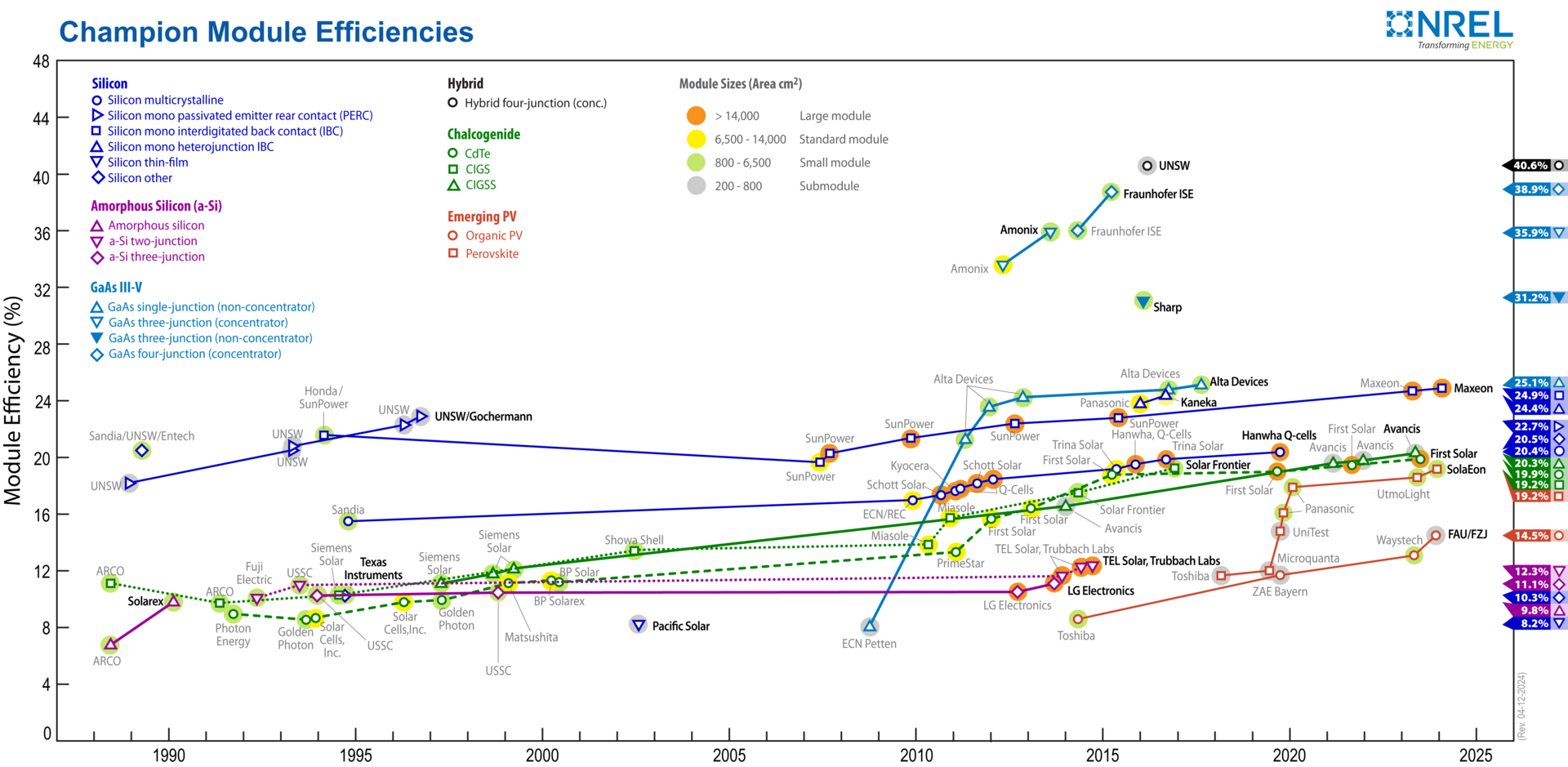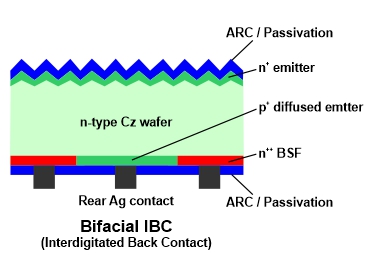The solar industry has witnessed remarkable advancements in cell technology, leading to a surge in module wattage and efficiency. NREL (National Renewable Energy Laboratory) regularly updates the latest cell efficiencies as shown in the chart below. Do be advised cell to module efficiency almost always drop when manufacturer starts to begin commercialization due to inherent scale up losses between cells in a module.

Back to module where the actual solar power generation matters. Here's a breakdown of the latest module wattage and efficiency levels, ordered from lower to higher efficiency, along with the corresponding cell technologies and manufacturers:
Lower Efficiency Range
Manufacturers like Jinko Solar, Trina Solar, and JA Solar have introduced modules featuring PERC (Passivated Emitter Rear Cell) and multi-busbar technologies, achieving efficiencies around 20-21% and wattages ranging from 400W to 550W.
The PERC cell structure is similar to a standard solar cell structure except with sophisticated backside SiN capping on the back. You can see the structure here of P-type and N-type substrates. Generally N-type cells are recommended due to its inherent immunity against Light Induced Degradation which lessens power of the module in early weeks or days of operation.
Mid-Range Efficiency
Companies such as Canadian Solar, REC, and Huasun Solar have developed modules using advanced N-type TOPCon (Tunnel Oxide Passivated Contact) cells, reaching efficiencies of 21-23% and wattages between 550W and 650W.
Here is a nice link that compares between PERC cell vs TOP-Con cell structures.
Higher Efficiency Range
SunPower (now Maxeon) has been a leader in high-efficiency modules, with their Maxeon series utilizing back-contact IBC (Interdigitated Back Contact) cells, achieving efficiencies of around 23% and wattages up to 670W.[1]
LONGi Solar's Hi-Mo 6 Scientists series, based on a hybrid IBC cell design called HPBC (Hybrid Passivated Back Contact), has reached a module efficiency level of 23% and wattages up to 670W.[1]

Aiko Solar, a lesser-known manufacturer, has introduced the Neostar Series panels with an impressive 23.6% module conversion efficiency using a unique ABC (All Back Contact) cell technology, surpassing 700W in wattage for their larger commercial panels.[1]
Highest Efficiency Range
Huasun Solar emerged as the frontrunner in 2023, introducing the Himalaya G12-132 HJT (Heterojunction) module, which achieved a record-breaking power output of 750.54W, coupled with an impressive efficiency of 24.16%, as certified by TÜV SÜD.[3]

It's worth noting that while high-powered panels above 700W have been announced, large-volume production is still in the early stages as manufacturing facilities and cell technologies continue to evolve.[3]
Bifacial modules may employ any of the above cell structures. Manufacturers squeeze more electrons by introducing transparent back glass and packaged product as a Bifacial module. This has added benefit of more power from the reflected solar irradiation from ground or reflections to the back ot module. They are typically heavier due to glass-glass construct.
Conclusion
Prices across the various types of modules are quite similar ranging from $1 to 1.50 per peak watt before installation; increasing efficiency of modules is one key focus area module makers employ to stay profitable. Installed price per watt is likely two to three times for all components, labor and regulatory costs. High efficiency modules benefit consumers as each square unit area generates more solar energy given the finite space to install solar modules in their estate.
Decision to buy which module types depends on factors such as availability in your area for the module, track record of manufacturer in terms of support and defect claims, cost per watt etc. Coming from a PV module testing background, I will personally buy HJT module due to its superior performance under low light to strong light conditions and low temperature coefficients as part of my cost-performance considerations. If you can wait, search out for reviews over time and buy the best value HJT modules you can get. Happy shopping for solar modules!
Author: Ken
References:
[1] https://www.cleanenergyreviews.info/blog/most-efficient-solar-panels
[2] https://ieefa.org/media/3719/download
[3] https://www.cleanenergyreviews.info/blog/most-powerful-solar-panels
[4] https://www.solarpowerworldonline.com/2019/11/what-are-heterojunction-technology-hjt-solar-panels/
[5] https://www.pv-magazine.com/2022/02/21/hanwha-q-cells-launches-590w-solar-module-with-21-7-efficiency/


